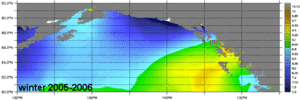Eddies in the Gulf of Alaska
Lively Data, September 18, 2008
The Gulf of Alaska is an identifying location of mesoscale eddies, all predominantly anticyclonic. Some of their characteristics, or their seasonal and interannual activity can be approached with the LAS. Eddies are generated on the eastern side of the basin and propagate westward parallel to the shelf break, in a eddy corridor of the Alaskan Stream.
The seasonnal distribution is not uniform. The maps of SLA show fewest eddies during winter (top) and most during summer (below).

Periods of increased eddy activity are known in bibilography and seem to be associated with local wind conditions. Maps of merged wind speed modulus during winter 2005-2006 and winter 2006-2007 show spatial and density pronounced differences. During winter 2005-2006, winds are predominantly located over the eastern basin and even they are less strong, they seem to be more favourable to a greatest eddy activity.

Seasonnal maps of the zonal component ("U") of geostrophic current also underline some interannual differences. U is marked by negative values, describing westerly currents during summer 2004 (bottom) which is correspond to a year of greatest eddy activity. At the opposite, the 1996 year (top) is noted as a lower eddy activity, during which the mean summer zonal component of the geostrophic current is positive, describing easterly currents.
Further information:
- Henson S.H., Thomas A.C., 2008, A census of oceanic anticyclonic eddies in the Gulf of Alaska, in Deep Sea Ressearch, I 55, 163-176.
- Image of the month, March 2010: Eddies in the Gulf of Alaska
- Applications: Ocean, Mesoscale circulation.
![]() Use the Live Access Server
Use the Live Access Server








